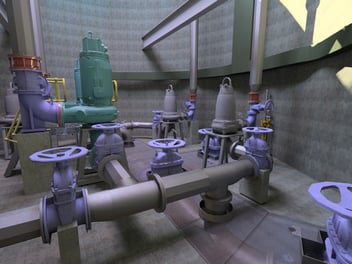How digital twins could transform water utilities' maintenance methods
As data revolution continues to impact the way we work and live, one technical director says the digitalisation of assets – digital twinning – has the potential to completely transform water utilities’ operation and maintenance methods.
Digital twin technology enables the creation of virtual replicas of assets and networks, offering utilities live, real-time access to infrastructure operations data, enabling a shift from preventive to predictive maintenance.
RedEye’s Jason Lancelot, who recently authored a white paper on digital twin technology, said one the the major benefits of digitising assets was the ability to access operational information immediately.
“Technology is constantly changing. There is a lot of work happening in data analytics, and one of the major products of this is integration between different systems,” he said.
“If you have a digital twin and you want information about a certain valve, for example, you can access that information immediately.
“If you are reviewing a system, you don't have to look all over the place for the information you need. You can go straight to one spot to get everything you need to know. It's a single source of truth.”
The ability to access information quickly and easily allows for much more robust decision making, Lancelot said, particularly in terms of when and where to invest in proactive maintenance.
“There is a lot of smart water technology at the moment. If a water authority has a digital twin – with all those smart meters and sensors linked together – they are able to access an array of information about leaks or drops in pressure, for example,” he said.
“Leaks are a classic example. Often utilities only receive reports of a leak if it’s really big. Utilities can access the information they need to know when and where this will occur, which is very helpful in terms of proactive maintenance.
“The issue can be resolved before it becomes a problem”
Real-time benefits
But bolstering maintenance decision-making is just the beginning – digital twinning can also enable a range of advantages in terms of assessing risk and cost-benefit analysis.
“You can start to create simulations of certain issues," Lancelot said.
"It allows for very robust and comprehensive scenario building, which allows for much more comprehensive planning.
“Enabling a real-time data feed is where digital twins really start to offer big advantages for operations and maintenance teams.
“While there are some companies looking at creating digital twins for existing assets, the real potential for digital twinning is in new assets or networks. It depends on what each utility is looking to achieve, but starting small can still offer some really great advantages.”
Lancelot said the sky’s the limit in terms of the potential benefits available to utilities through digital twin technology. However, there are a few considerations that need to be addressed.
“One important point is that a platform is required to host a digital twin,” he said.
“Change management is also something that needs to be considered when deciding to take this type of digital route. Furthermore, how far do you want to go with the digital twin? Maybe you don't want to integrate everything into the digital twin.
“If there is anything that’s considered dangerous to integrate, maybe you wouldn’t include that element of the asset. It might be enough to simply include pump efficiencies and water quality.”
Likewise, Lancelot said cyber security is a very important risk to consider and plan for in terms of integrated digitalisation of assets.
“Integrating systems in any digital scenario will always carry the risk of cyber attack,” he said.
“How to prevent this is the biggest challenge. A lot of water utilities don't want to expose themselves to that type of situation. For some utilities, they would only want the digital twin to get to a certain level of automation.
“But, if we can sort out data security, in future this methodology will enable utilities to do whatever they want with their digital twin.”

